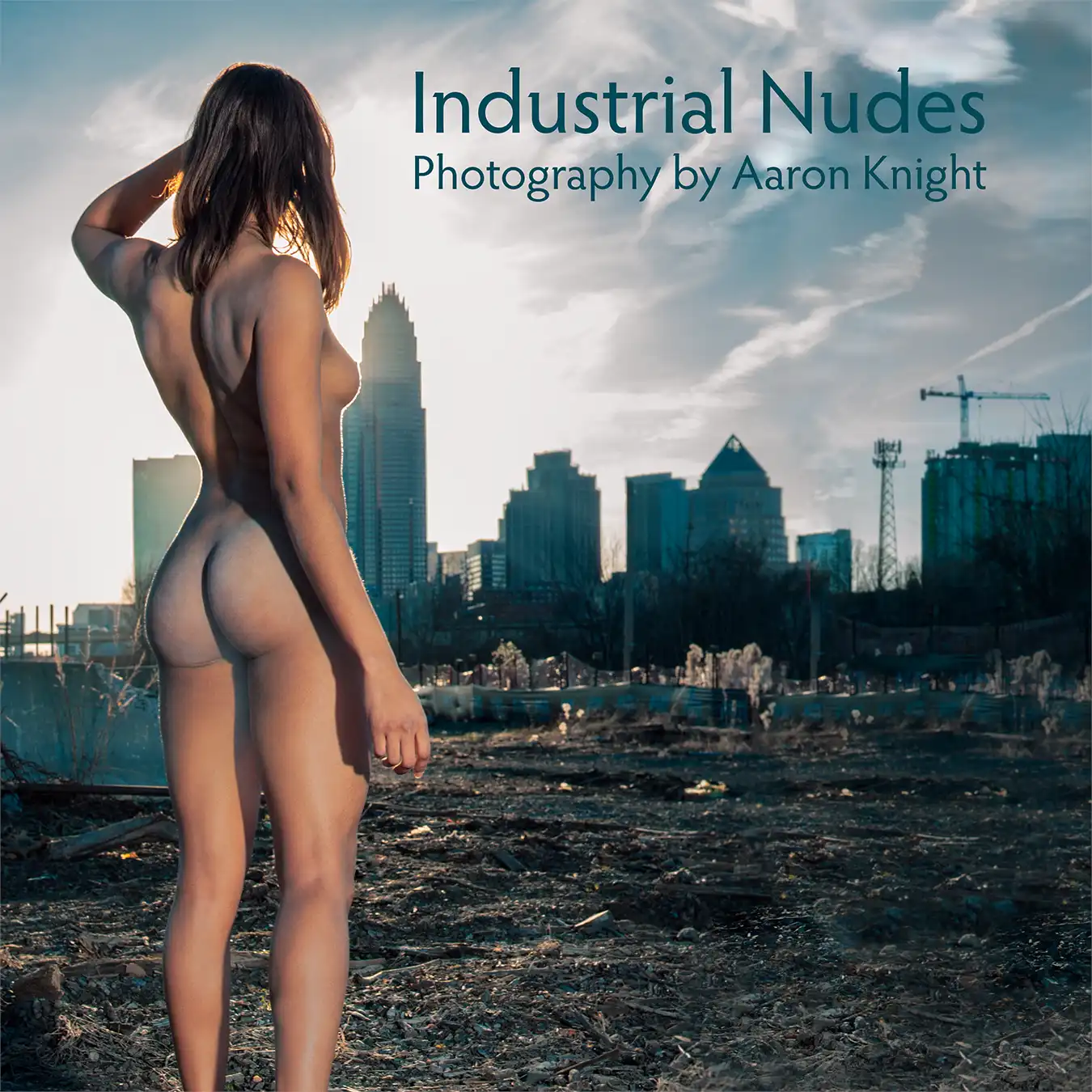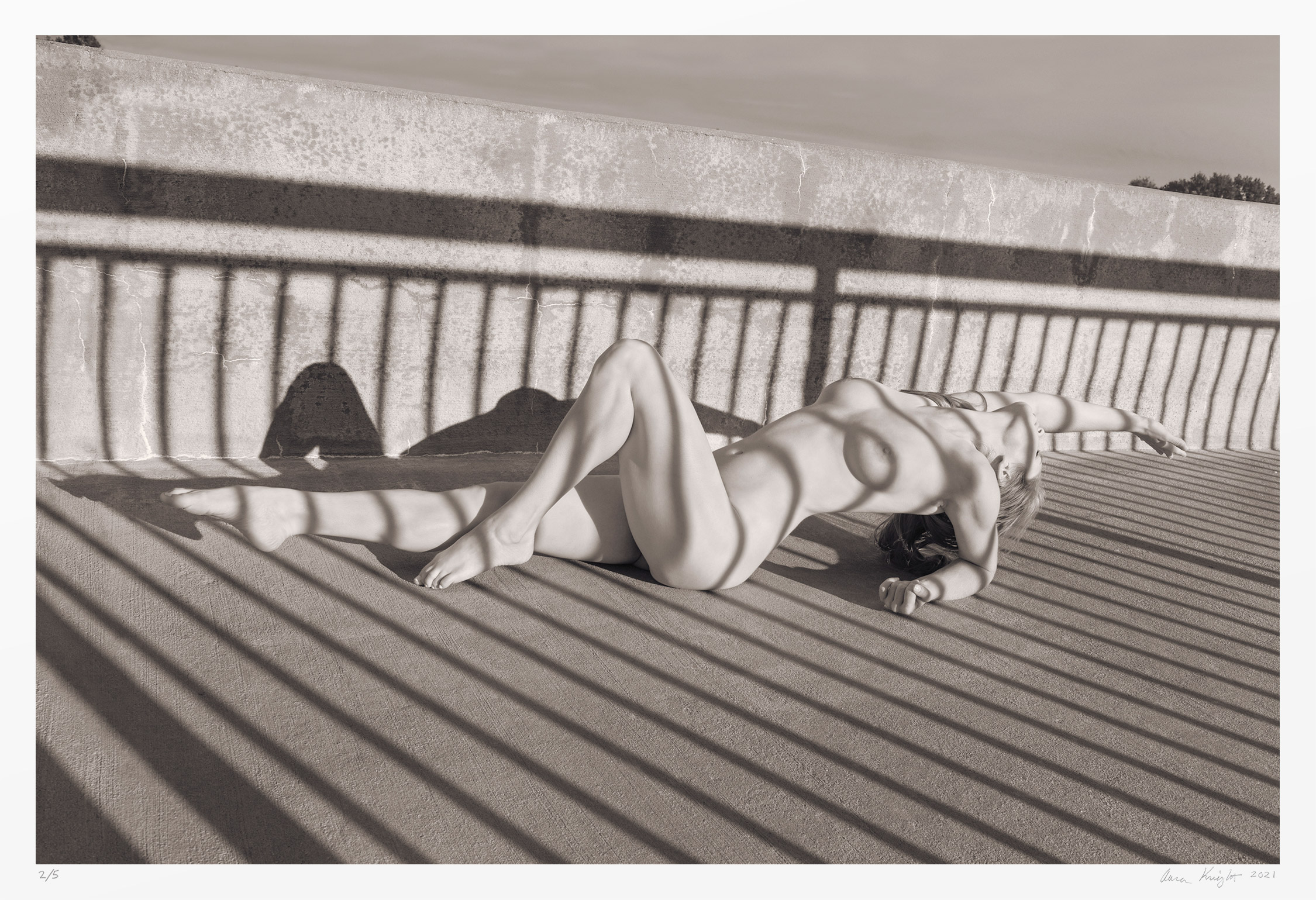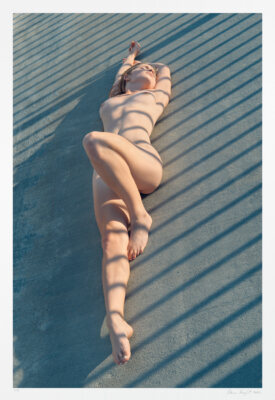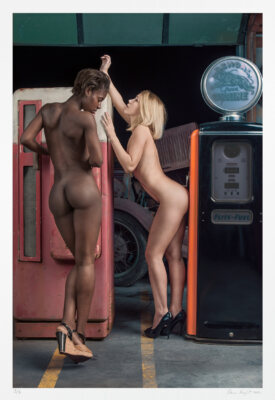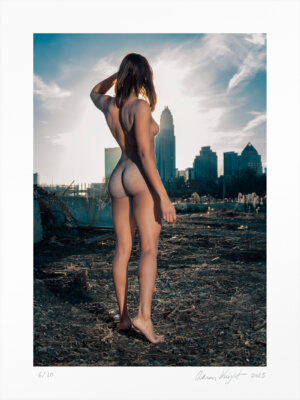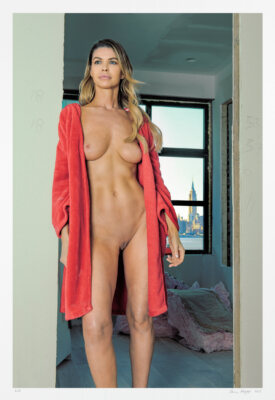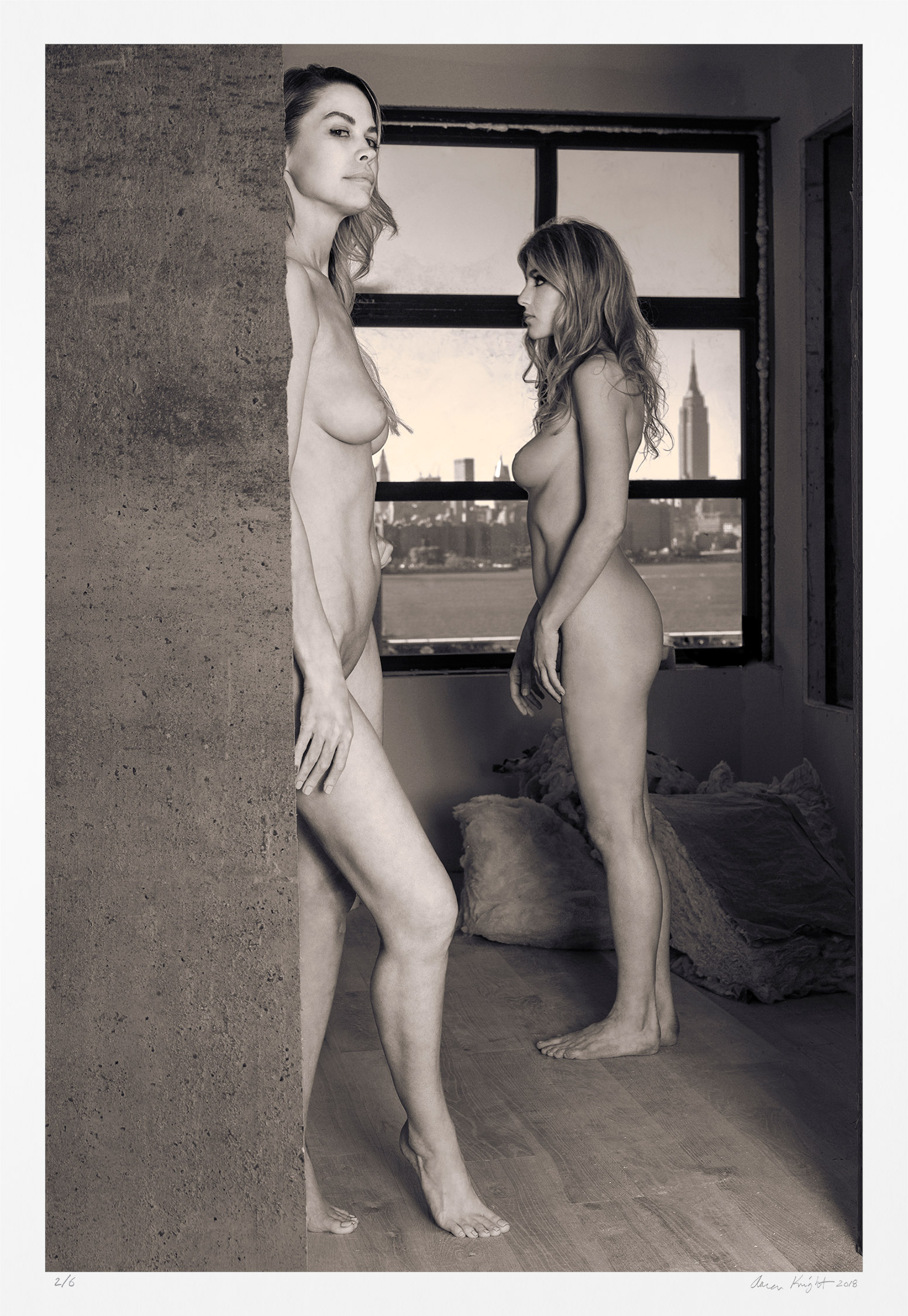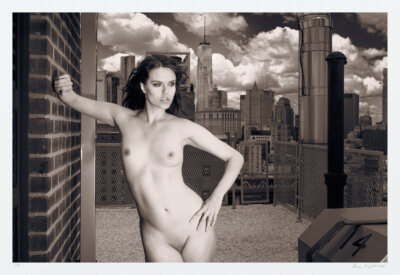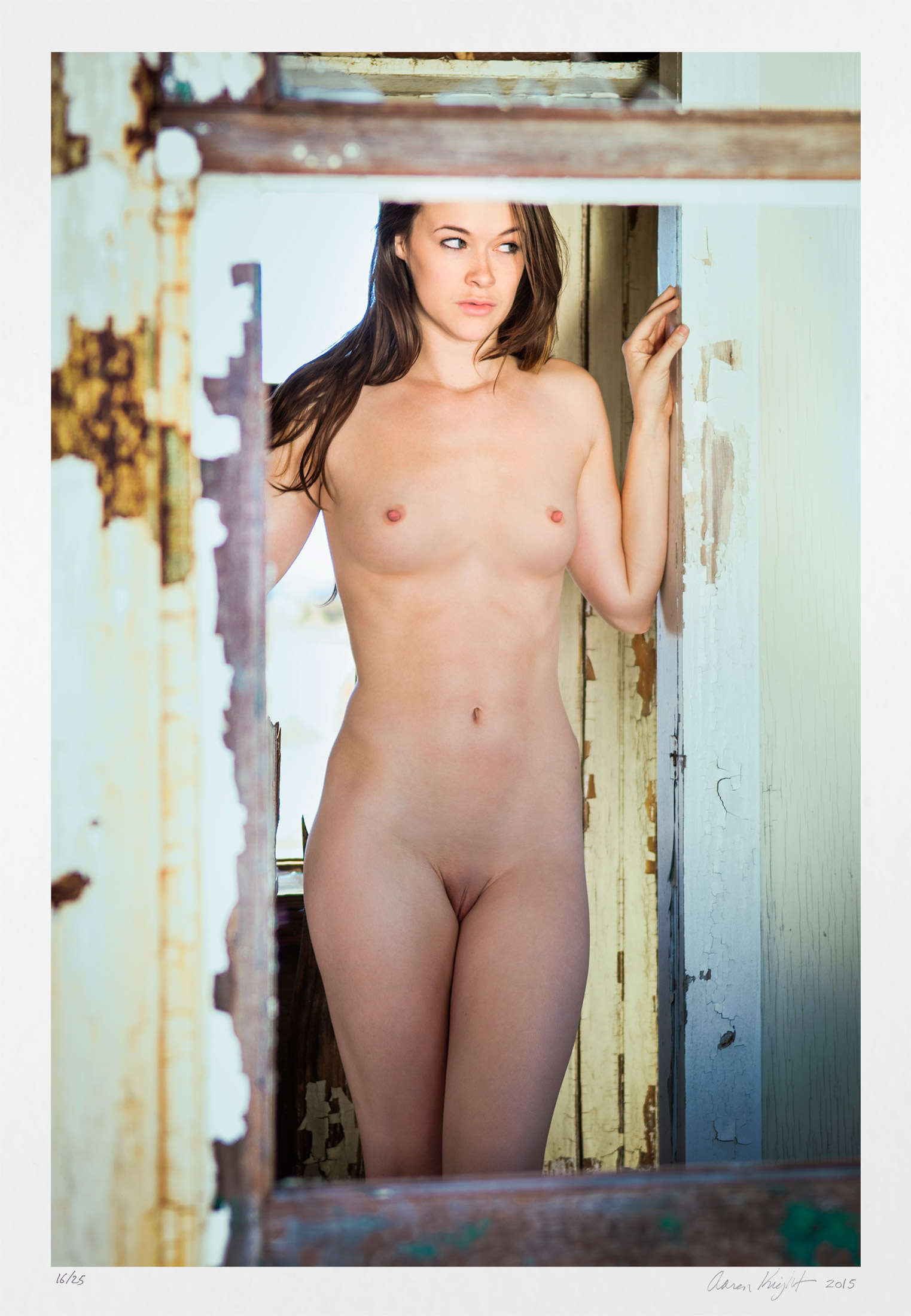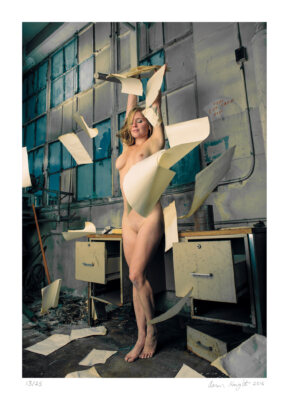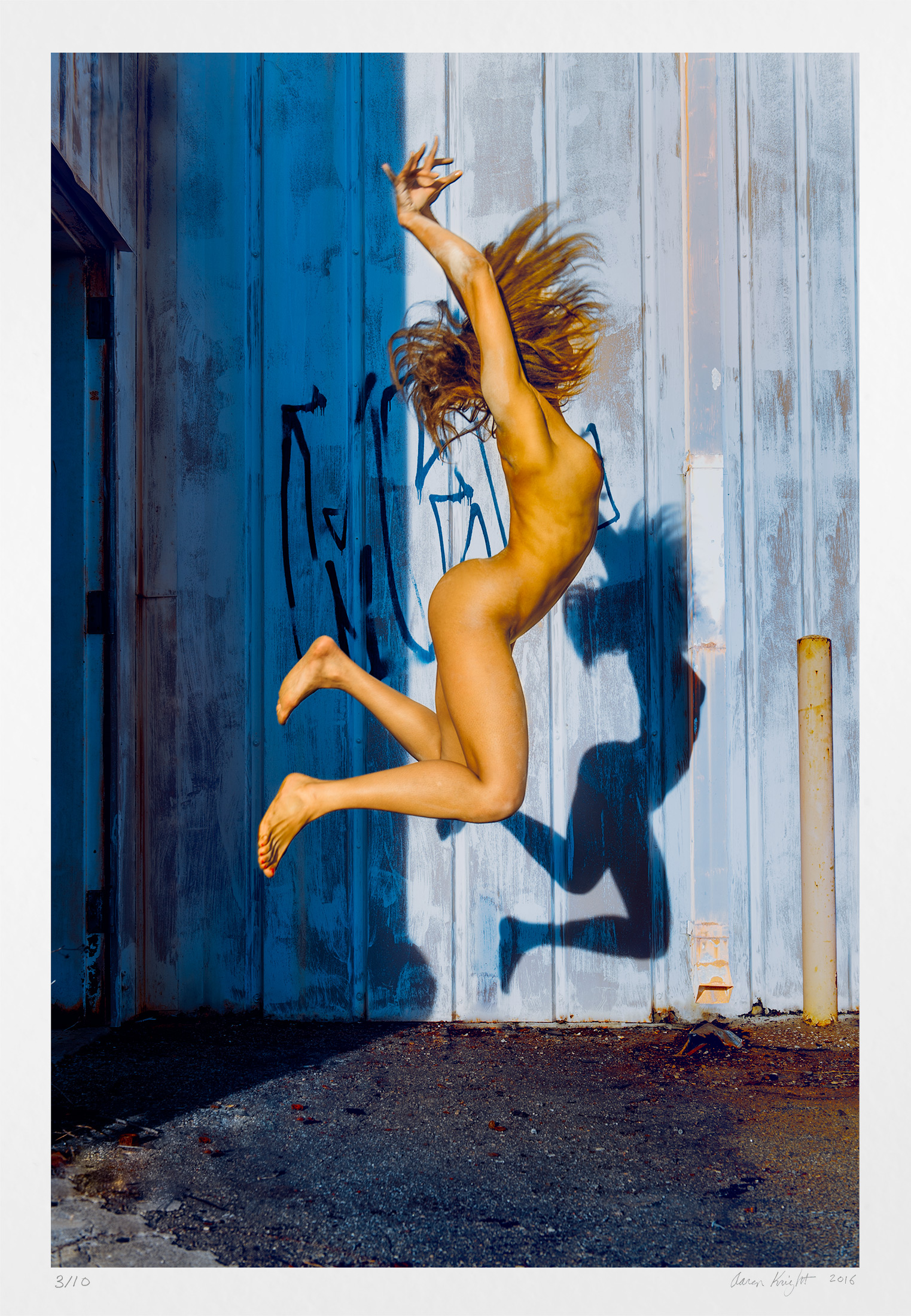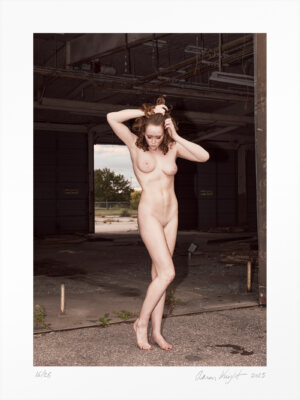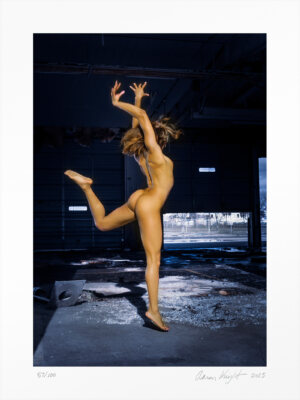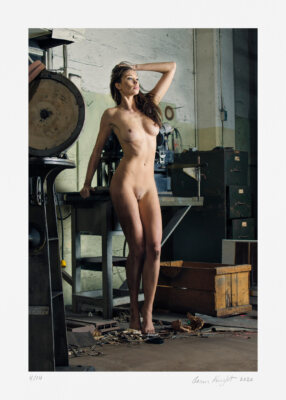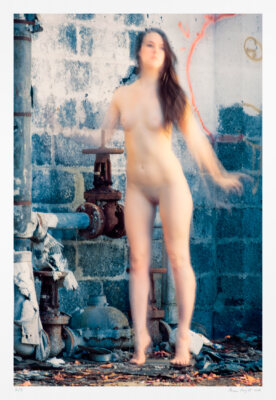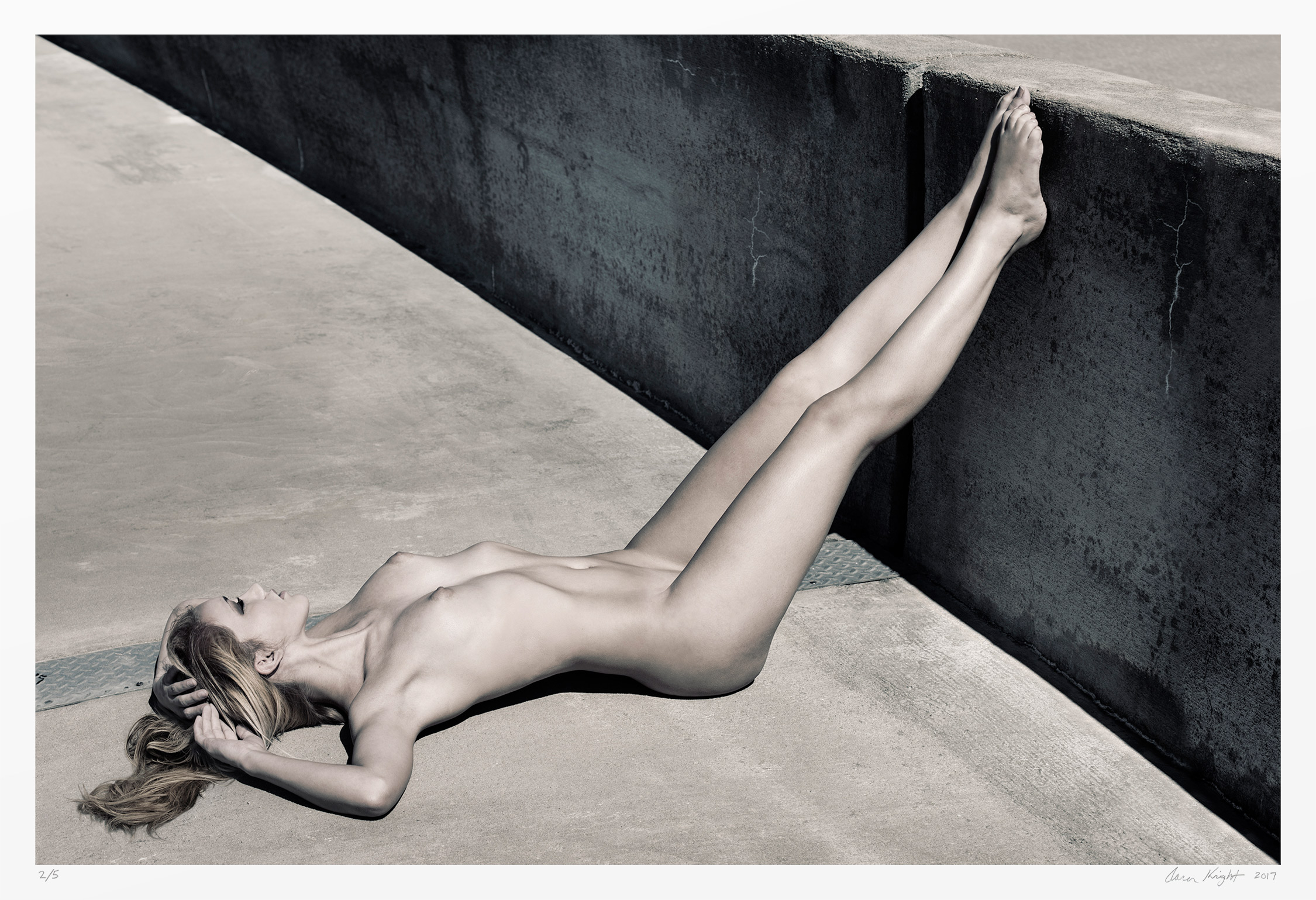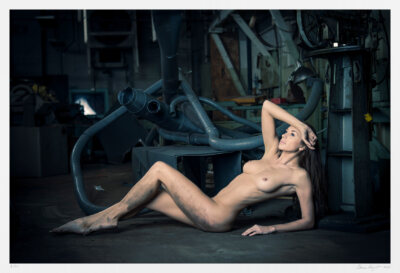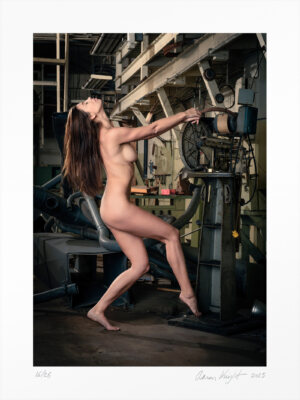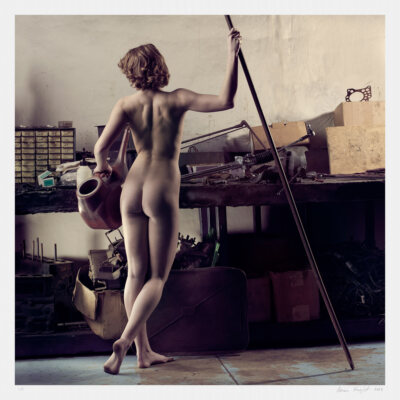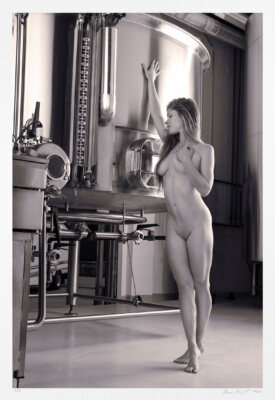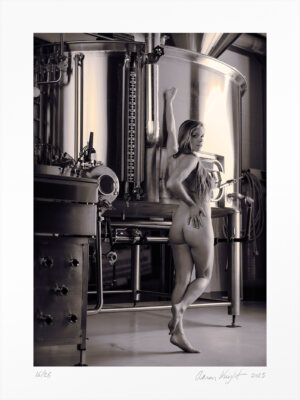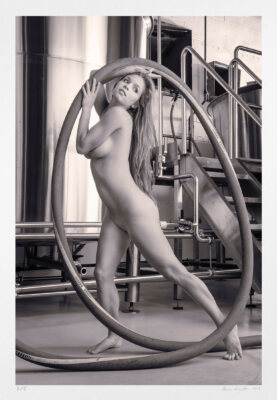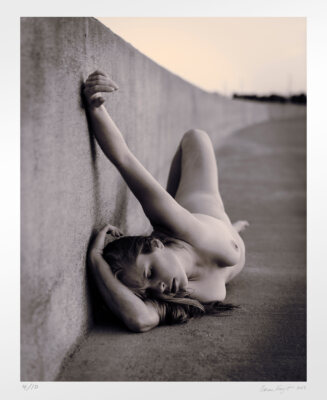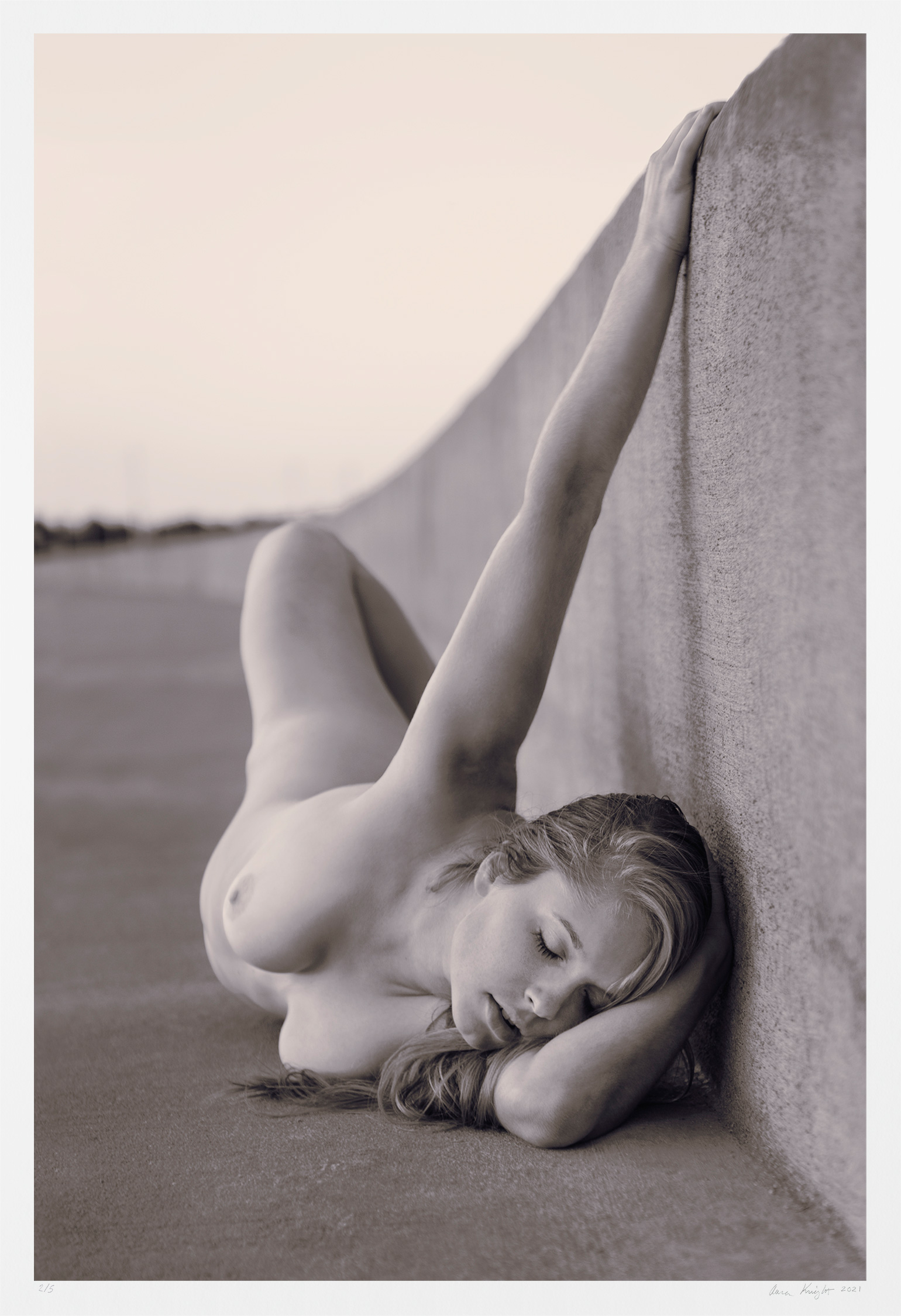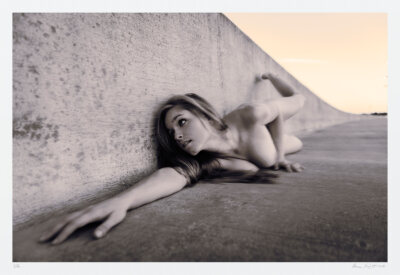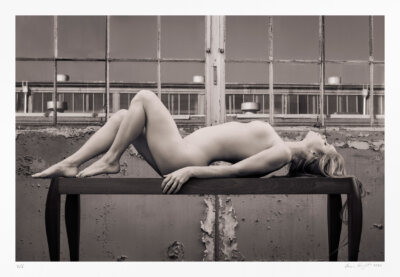Industrial Nudes
The theme includes urban exploration, abandoned places, factories, machines, and, of course, nude models. With the nude form set against unnatural environments of concrete and chrome, this series contemplates the contrast between the mechanical and the organic; the clean and the gritty. Even the strongest human body is slight and delicate when compared to the rigid, bulky elements of the industrial backdrops. This theme of industry includes places of manufacturing, construction, as well as completed structures. It is, at its base, a commentary that compares an idealized “human as an animal” to humanity’s perpetual expansion into nature. Some scenes are devoid of the natural world, while others show where industry protrudes into the natural world. The images also celebrate the beauty of industrial achievement, by showcasing icons of mechanization in conjunction with the splendor of the human form. The images are intended to be contemplative rather than declarative, introduce topics for discussion rather than expressing opinions. The presentation is mostly visual and individual interpretations will vary if one draws any conclusion at all.
Artist Aaron Knight is fascinated by the mortal form set against a rigid, gritty industrial backdrop or gleaming machinery. He has explored numerous locations full of concrete, steel, flaking paint, chrome, and rust. Some are abandoned and decaying others are part of bustling small businesses.
Thank you to the subjects who endured many hours of uncomfortable surfaces, chilly temperatures, exhausting poses, and stressful schedules, all while appearing serenely calm in the images. These brave and beautiful models have ventured with me into interesting, grimy, and somewhat challenging situations to create a series of images that were anything but trivial to produce. In order of appearance, they are: Charity Graves, Samantha L., Gabby Aurele, Hope, Emily, Peyton, Jorgie Mason, Ava Moss, Megan N., Haley, Elena Marie, Marisa Heins, Maria E., Astrid Kallsen, and Evilyn D’Angelo.
The content includes the images you see here, plus many more, and Knight’s written thoughts on the processes, locations, and collaborators that he worked with.
Introduction
This collection of images features the allure of the female form among unnatural environments of concrete and chrome, such as abandoned factories, gritty work spaces, and machine shops. There is a fascinating contrast between the mechanical and the organic, the clean and the grimy. Even the strongest human body is slight and delicate compared to the rigid, bulky elements of the industrial nudes’ backdrops. This theme of industry includes manufacturing facilities as well as modern structures. At its base, it is a commentary that compares the human as an animal to humanity’s unbridled imposition on nature. Some scenes are wholly manufactured, while others show where industry protrudes into natural habitats. The images also celebrate the beauty of industrial achievement by showcasing icons of mechanization in conjunction with the splendor of the human form.
This compilation has two major themes: a cycle of birth and decay, and the way a rigid industrial background can emphasize the flowing beauty of the female nude. The first notion is weighty, but the second offers a dreamworld to escape reality.
The concept of time is central to contemplating the cycle of birth and decay. We transition from cherished monuments to abandoned ones. Open spaces allow us more than a glimpse of the natural world, contrasted in turn by a sterile production facility.
Birth, the act of creation, is embodied in scenes of production. The counterpoint is the inevitable decay when industrial apparatus are forgotten or simply exceed their usable lifespan. Such scenes provide gritty, texture-filled tableaux for the eye to explore. Abandoned and decaying settings are rich with patterns, and the passage of time only enhances the variety of textures.
The aesthetic of this compilation is anchored in a celebration of beauty. The hedonic appeal of the central characters is not compromised by the altered colors, grungy locations, or displays of architecture. Each composition blends or contrasts sensual subjects with their industrial surroundings.
The diminutive scale of the figure is repeatedly contrasted to vast monuments and manufactured surroundings. The proportions of the body provide a known standard by which we interpret distances and dimensions. The inevitable comparison is how even the most robust figure is frail and tiny compared to an industrial landscape or mechanical apparatus.
The images in this collection are more contemplative than declarative, preferring to introduce topics for discussion rather than voicing clear-cut opinions. Although his thoughts, questions, and interpretations are expressed throughout, the presentation is mostly visual. Individual interpretations will vary, if one draws any conclusion at all. This presentation is arranged visually, with significant overlap, each section highlighting aspects of the motif. With this collection of images, you can contemplate humanity’s relationship to the industrial landscape or simply enjoy the bizarre beauty.
Monumental
This series contemplates the scale of the nude form contrasted with monumental structures of concrete or metal. Monuments to ingenuity, such as an abandoned bridge, will stand against the elements. Architecture represents the technologies that allow a comfortable lifespan beyond that of our hunter-gatherer predecessors.
A lithe woman lies on her back with her feet against a disproportionately massive concrete barrier. A diagonal line divides the space into light and dark halves. Her bent body bridges the two halves. Muted, almost lifeless tones connect the pale skin to the drab concrete and steel plating. The dystopian palette quiets the would-be cheerfulness of a sun-drenched body. Her posture, although seemingly at rest, suggests an uneasy tension. The solid structure is an appropriate metaphor for the stability that technology and development bring to our civilization.
A high-rise rooftop lets us survey a city skyline and contemplate the two figures which dominate the foreground. The skyscrapers in the distance are a demonstration of scale; they are a minority of the composition, representing countless lives. Chain link fence and a brick wall emphasize the division.
Railway container cars dwarf the explorers as they climb and wander. The scene evokes the image of a vagabond, vulnerable to the massive metal conveyance. The soft, warm illumination between the vehicles contrasts with the harsh daylight in the distance. The train cars themselves are strewn with a mix of signage and evidence of the passage of time in the form of deteriorating paint and bubbling rust.
A figure leans seductively against a door that must have been brilliantly painted in its day; now, rust and soot create fascinating patterns that subtly change across the door. Streaks of rust reveal where rainwater has chronicled the years. Unexpected relics complete this surreal spectacle.
A mysterious array of concrete pillars forms an otherworldly vista. The lawn is inexplicably well-manicured, yet this place seems otherwise abandoned. Twisted barbed wire intertwines with vines atop the mangled perimeter fence. A statuesque nude appears at home, stretching between the concrete surfaces.
Abandoned
Crumbling textures often become more intricate with age. An abandoned space in an antiquated federal government building demonstrates this effect. There is no escape from the accumulated filth in this vacant wing of the structure. A figure emerges from the darkness as she ascends into this space. She holds the flaking rails of the stairwell that plummets to the obscurity below. Cool blue-green hues contrast sharply with the warm colors of the subject as she injects vitality into the lifeless space.
At the top of the steps, daylight energizes the space and emphasizes the contours of the figure’s arm, up-tilted head, and her outstretched leg. Her body aligns with the multitude of horizontal and vertical lines in the image. Her posture is at once a geometric integration and a sensual display. The slope of the top of the building against the blue sky is a vague echo of the diagonal railing visible in the lower corner of the image.
Looking up the stairs, we see a metal barrier with diamond-shaped openings. Closer to the defunct cage, a figure curiously explores the metal mesh wall which once protected valuable equipment. Metal bars and mesh that once kept out would-be thieves now serve as a spontaneous perch for the adventurer. The distinct smudge on the sole of her foot hints at years of neglect. The mesh is a single plane of clarity and fades quickly from sharp focus into murky background shapes. The cage walls provide a repeating diamond pattern that adds structure to the overall composition while it divides the background. The two-tone concrete wall creates an interesting visual division in the composition.
In one image, the subject wears black western boots while clinging to the outside of the cage. Western boots add a hint of personality and bridge the divide between her and the industrial elements. In another image, she balances, barefoot, on the narrow lip at the bottom of the cage wall.
Behind the mesh, a drainage grate and a hand-built equipment rack sit in shadow. Bits of rope, cigarette butts, candy wrappers, and dirt litter the concrete floor. Inside, a figure poses on the ad-hoc wooden equipment rack. A palette infused with warm, glowing, amber colors harmonizes with the subject’s honey-toned skin and hair.
A series of images depicts ascension, by going up a staircase or climbing a rope. These actions connote feelings of struggle and triumph, confinement and liberation. A nude on stairs is a motif many artists have employed. The theme of suspension concludes with a figure connected to a ceiling beam by a climbing rope. The cord wraps around her limbs and torso, a contrast to the straight lines that surround her.
In a series of images, a desk is a relic representing decades gone by. The filth is punctuated by an ashtray and packages from the associated noxious habit. The set concludes with a multitude of papers thrown into the air and the dilapidated desk drawers opened.
Open Spaces
This sequence shows two ends of humanity’s intersection with nature: our ever-expanding encroachment into the wilderness, followed by the subsequent decay of our forgotten novelties and monuments. The scale of the figure is emphasized by an expanse of landscape and an engineered environment.
A female sports a carefree demeanor on a “bridge to nowhere,” spanning the marsh to the site of a housing development that was never built. Various elements underscore a sense of depth. Power lines and street lights recede into a distant tree line. The snaking concrete barrier diminishes with perspective. The distinct ridged pattern in the roadway at her feet recedes into a uniform gray. Her shadow protrudes to the edge of the image.
A rundown pleasure boat, balancing precariously on a stack of wooden blocks, seems hastily forgotten. Plucked from the water and past its prime, this once majestic cruiser sits motionless and crumbling, its engines and horns silent, its cabin overrun with insects and greenery. The flybridge canopy and upholstery have succumbed to the elements; flaking finishes and stains are its new look. This giant’s wood and metal are peeling and separating as saplings grow up in front of it.
Railroad tracks provide powerful symbolism. The tracks and tree line radiate from the center. The converging lines extend seemingly boundlessly toward the horizon. With her back to us, she is on an expedition, a story that makes us curious about what is beyond what we can see.
A single figure is idyllically silhouetted against the setting sun and the distant Charlotte skyline. The three main characters in this composition are the flat rubble, the rising buildings, and the close figure. What first appears to be a wasteland of an urban environment is a construction site and a rebirth story. The current state of broken concrete and steel reinforcing bars will give way to revitalization. The rubble is a raw reminder that for every beginning, there is an end.
A storm approaches an abandoned section of bridge as a woman leans on the railing over the wetlands. The image implies proximity to a populated area, across a flourishing marsh, into the edge of nature. It symbolizes our ever-expanding reach, for better or worse, into the natural world.
Production
Gleaming manufacturing equipment and the shiny metal of freshly cleaned machinery provide a high-spirited backdrop for these photographs. Chrome pipes, massive hoses, and sleek towers of metal set the stage to display industry in its prime. Observing the clean, shiny production area, we can imagine the sounds of busy workers kegging a new batch of beer around the corner. From the brewhouse control panel to the mammoth tanks and hoses, her upbeat shine reminds us to celebrate the fruits of technology and industry. The subject periodically acknowledges the viewer with a glance. Aesthetically, these arrangements are about line and pattern. Clear vertical, horizontal, and diagonal lines cut through the presentations.
Our heroine investigates patterned metal decking, polished railings, piping, oversized hoses, and enormous vessels of beer. Her hair and skin radiate with the warm tones of honey and wheat, hinting at the fermented product nearby. This series is clearly influenced by classic pinup style, as well as advertising, which frequently pairs a voluptuous woman with a product. Whether to interpret the series of images as a whimsical indulgence or a wry commentary is the choice of the viewer.
Our explorer is dwarfed by the scale of hoses and pipes as she traverses her environment. Crouching under the equipment calls attention to the disparity of proportion. An open door reveals activity outside in this active commercial district. She poses just a short distance from the out-of-focus trucks and loading docks, establishing two alternate realities in this surreal juxtaposition.
Straight lines dominate these images. The predominant colors are sapphire and gray steel, accented by occasional copper fittings. This muted palette and linear structure are punctuated by the presence of her curvaceous body and cascading hair. A bright red hose disrupts the visual congruity when it meanders behind her legs. She demonstrates her strength by lifting a massive loop of hose that forms an imposing circular design around her.
Nearly colorless, these toned images are condensed to their compositional building blocks. These near monochrome abstractions guide the eye through line, shape, and texture, without the complication of a color palette.
Storehouses
Industrial production generally necessitates storage. As industry’s footprint shrinks and migrates, yesterday’s vast warehouses and depots are abandoned or repurposed. These cavernous spaces and their grounds often provide geometry and patterns which are fertile fodder for creative imagery.
At a deserted loading bay, deterioration forms fascinating patterns of water stains, moss, and charring. Green sprigs and leaves spring up from the asphalt and concrete. The bumper at the edge of the loading dock creates a bold, almost black horizontal line that bisects the image. Located near a deep-water seaport on the South Carolina coast, this building may have housed coal for the steel mills or tons of wire rod for export.
A figure explores visual possibilities of posing the body against a concrete block wall. The peeling paint makes interesting patterns of dark green and bright blue. The concrete ledge elevates her position in the composition. A rusted and flaking metal plate adds visual variety, and an intriguing suggestion of the unknown space she faces beyond the edge of the picture.
Brightly colored shipping containers contrast with the body, bathed in the golden light of the last of the afternoon sun. The strong, repeating vertical pattern of the corrugated sidewalls visually separates the background from the subject. The mobile nature of these storage and shipping containers prompt us to contemplate both time and distance.
Piano wires add dazzling colorful arcs to a rusty freight elevator in the storage area of a musical instrument rental business. Close cropping of the body emphasizes the claustrophobic space and puts the viewer’s attention on the shadows along her curves. Tight patterns are visible in the coiled wires, the mesh elevator enclosure, and the pitted metal beams above her.
A figure poses in the glass block window of a warehouse in downtown Charlotte, North Carolina. At one time, this warehouse was filled with bulk goods; it now houses an artist’s studio, antiques in storage, and a music rental business. Cold daylight filters through thick glass blocks, backlighting her.
Construction
Construction can look like chaos at first glance. A single figure stretches her arms upward in the midst of a commercial renovation where old materials are being preserved for restoration. The room is at its most basic—the point where everything has been removed for refurbishment—a turning point between past and future. An ashy wooden panel door and drab concrete block wall form a neutral background. Long, straight diagonals of propped-up lumber bridge the foreground and background. A strong sidelight helps the figure stand out from the disorderly lines and tones behind her.
Sitting in a drainage conduit, the massiveness of the concrete cylinder underscores the softness of the figure. A commercial building sits in the background, below the berm, with its roof nearly eye level. Inside the pipe, light bounces from the curved surface, and the body seems to glow. Her caramel skin stands out against the blue hues of the cement cylinder. The concrete is flanked by tufts of drying vegetation; small clues about the surrounding area.
With a nude figure standing next to the drainage conduit, the entire construction site and distant skyline give us context. The setting sun keeps the passage of time in the back of the viewer’s mind.
A figure stands out against a plain cinder-block wall. Her raised arms and outstretched leg glow against the drab space around her. The off-center stance is visually balanced by the placement of her vertical leg and the objects propped up nearby. Flaking paint hints at the age of the building.
Daylight flowing through panes of window glass breathes life into a somber interior under construction. The blue outside light colors the floor. The grid of the window panes echoes the frames and other straight lines in the composition. The subject’s body divides the image into left and right halves, and leaves a negative space between her raised arm and leg, through which the background can be seen. The uncluttered floor provides a small sense of order in the otherwise chaotic array of shapes.
Decay
All that we build, if not maintained, eventually falls apart, and nature creeps back in. Grass overtakes asphalt and vines break concrete apart. An enthusiastic dancer confronts the melancholy scene. Her bronze body contrasts in tone, color, and kinetic vitality with the bleak, static backdrop. The cold atmosphere is punctuated by shattered glass on the floor. Seemingly unconcerned with the hazards, she blazes defiantly through the chilly scene with an explosion of confidence. Faint yellow lines show where vehicles once parked for service. Dangling wires and debris fill the frame at the top and bottom. This long‑abandoned service garage encourages us to explore the patterns of texture and color throughout.
A child’s school chair hints at an eerie story. The hauntingly familiar chair with a built-in writing surface and storage basket lies on its side at the subject’s feet. Strong light sets the mood here. A bold shadow creates an almost-vertical line from the blue backrest of the chair to the top of the composition.
A figure poses in a collapsed building with the remains of the roof strewn across the floor. A roof truss angles downward from the corner. The sky is visible at the top of the image, accented by a dangling electrical wire. A barefoot figure disconcertingly stands on roof tiles amid upturned nails.
Among the ruins is an ethereal specter; her shimmering movements echo the gradual disintegration of the building. These indistinct images portray the passage of time on multiple levels of scale from minutes to decades. Her rosy complexion contrasts with the gray concrete and rusted valve.
Sickly colors of a rural junkyard set the mood for a peculiar automobile pinup. The 1960s‑era muscle car is a shell of its former self and a home to moss as it slowly succumbs to the elements. The narrow passage between the concrete block wall and the car, blocked into a dead end by debris, creates extremely soft light on the model.
A single figure posed against a window and wall with peeling paint contrasts life with the decay. Under her is a brand new, custom‑made hardwood table. The handmade table hints at the reuse of this industrial building for new enterprises.
The imposing physique of a statuesque female pairs with the vertical pillar of an inoperative industrial saw. Conduit that used to be on the ceiling now lies on the floor. In the series are a plethora of menacing shapes, yet she seems oblivious to the hazardous surroundings.
A nude figure lays with the rubble of concrete and rebar in the aftermath of demolition. Graffiti seems apropos in a demolished skateboard park.
Standstill
Two trolley cars sit motionless. These workhorses from nearly a century ago were retired from transit service in Charleston, South Carolina. After the American Civil War, the town’s streets were lined with iron tracks for the cars, which were initially horse-drawn. The vast, desolate, vacant lot is visible through the windows and behind the mid-ground. This context adds to the quiet atmosphere. Years of vandalism and deterioration have left thought-provoking textures and patterns. The years of neglect and abuse prompt the viewer to contemplate the trolley cars as historic artifacts, which adds to their visual charm.
It is compelling to contemplate the experiences and sights, including photography, that must have happened in and around the cars over many generations. One can imagine a coach packed with riders, traveling down the tracks. This place, seemingly frozen in time, conjures thoughts of not only time but also movement. This makes it an attractive curiosity to be photographed in, and this was also undoubtedly the case when it was pristine.
The youth of the figure reminds us that our structures become legacies that persevere after the makers have succumbed to the effects of time. These trolley cars have stood for longer than most of us will live.
The choice of camera angles in this series is to give a sense of the spaces—in front of, inside, and behind the trolley cars. A glimpse of the horizon and sky, as seen through a series of parallel windows and doors, draws the viewer’s eye through the depth of the space. Each window, wall, and doorway is an opportunity to layer the image.
Where both trolley car doorways line up, we see a repetition of the rectangular shapes, with the figure standing in the closer doorway. Golden tones splash on the figure’s side, in contrast to pale greens and blues of the flaking paint around her.
Bold, orange, rusted metal plates and massive bolts recall a thriving era of robust iron structures built to pass the test of time. The oxidized metal tones separate the image into thirds: the rusty metal in the foreground, the mid-ground with the nude figure, and the background framed by the doorway through which it can be seen. Each of these vertical swaths fit together to indicate depth. A nest of wasps is an indication of how nature spreads into our habitat without humanity’s constant cleaning. The body remains partly obscured by the doorway into the next chamber of the trolley car, signaling her movement through it.
Creation
Workshops run the gamut from clean to dirty. The process of creation is built on layers of technology. Simple tools are used to create more complex ones, which in turn are used to fabricate products. The incongruity of a naked body with sharp drills, powerful motors, and heavy objects creates a mischievous caricature of the activities we might imagine normally taking place here.
A single figure explores a variety of old machines, including this early Bridgeport milling machine. Still functional, it is used for drilling metal to fabricate custom tools and mechanical adapters. The large dials and knobs recall a long-past era. In the background is a Cincinnati Machine Company horizontal milling machine. This device dates back to the early 1900s and sports large woven canvas drive belts.
The complicated backgrounds of these scenes remind Knight of old Dutch paintings that he studied in museums and books. The prevalence of browns and neutral cool tones also evoke the painted palettes, and he adjusted the colors to more closely match his recollections. The shop is filled with repeating shapes of rounded corners, circles, and sweeping curves.
With a sledgehammer in hand, a kinetic image imparts a feeling of motion. The viewer interprets what has just happened and what is about to happen. Parts and tools populate the dark background.
Propped against a 1970s-era engine block, with a wrench in hand, a flirtatious acknowledgment of the viewer recalls the themes of quintessential pinup art. Her single supporting leg is a bright vertical amidst the dim negative space. Her head is tipped toward her body to achieve both visual and physical balance. Light outlines her hair and body, emphasizing the depth of the shadowy space.
At the end of the theme of creation, a figure is posed on a steel platform in front of a wall lined with sound-dampening material. The textured wall covering creates a uniform pattern in the background. She uses the rigid metal structure to strike a variety of contortions. This is the showroom adjacent to a sculptor’s workshop. At the far end of the spectrum, the space is clean, uncluttered, and only vaguely industrial in appearance. The sturdy sculpture pedestal and sparse background are ideal for the display of acrobatics.
Limited edition photographs on the industrial nude theme:
The following limited edition photographs are separate products, related to the industrial nudes theme. The following images do not necessarily appear in the book listed above, which is a separate product.
